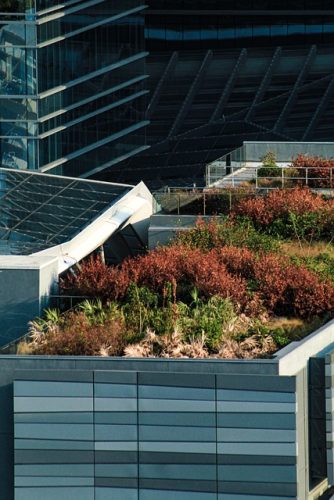Introduction: What is meant by Eco-Architecture?
Eco-Architecture means designing and constructing buildings in a way that reduces the overall harm and impact done to the environment in the process. Eco-Architects do this by taking into consideration many components such as using sustainable construction material that reduces the overall cost and carbon footprint, conserving energy and water etc. It is also known as ‘Sustainable Architecture’ or ‘Green Architecture‘ for this reason.

Also check out: Eco-friendly, Sustainable Interior Design- How to Do it?
What is the Importance of Eco-Architecture?
We are living in the Anthropocene era, which means our impact on the Earth is so huge that we are currently living in what can be called as “Concrete Jungles” devoid of any nature or biodiversity that is hurting the planet and us eventually. So, there is no other choice except to rethink and change how we build our cities and proceed with our lives from now onwards. This is done in the form of sustainable development which included building sustainable residential complexes and monuments that can work with nature instead of against it.
Eco-Architecture aims to design buildings that are in the best case scenario, self sufficient and uses the resources around it to maximize the efficiency with which the energy and water supply is being utilized both. during the construction period as well as when residents move in.
What are the Main Features of Eco-Architecture?
There are some features that all green architecture is required to possess to be characterized as such, those are:
- The buildings/architecture should be Energy Efficient.
- They should be Net-Zero buildings, i.e. capable of sustaining themselves due to renewable energy generation.
- They should be Water Efficient.
- They should be built to manage and withstand stormwater and other natural events.
- They should have proper ventilation system for the best indoor environment and air quality.
What are the basic Methods/Techniques used in Eco-Architecture?
Some basic Techniques include:
- Using Sustainable Construction material that incorporate aspect of nature such as using Hempcrete instead of concrete, using bee bricks instead of regular ones, tiles made out of eggshells etc. For more information, check out: 10 Latest Innovative Environmental Friendly Technologies
- Recycle any waste generated and segregate construction material waste at the source.
- Adapt and reuse old building spaces and restore them.
- Taking the orientation of the building into consideration by designing it in such a way that reduces the need of lights during day. This is possible in passive sustainable designing by accounting for the direction of the sun and wind to conserve energy. This allows the building to use less electricity.
- Consulting with Engineers and other relevant people for using the best energy efficient plumbing, insulation and HVAC systems in the building that last for a long time.
- Designing buildings that are capable of harnessing and running on renewable energy sources such as wind or solar energy
- buildings are built by taking into account the landscape and natural environment or possible ecosystems around it.
- Sourcing materials and furnishings like carpets, paints and upholstery etc. from sustainable sources and environmental friendly companies.
- Rooftop Gardening- allowing roofs to be used as a space for home gardening, greenery or vegetation to improve air quality and regulate building temperature.
- Using sloping walls to allow more daylight to penetrate the building.
- Drainage system that allows reuse of storm water for various purposes such as greywater flushing or even to just cool the buildings by flowing inside the plumbing of walls
- Thermally insulated walls in cold regions or installing cool towers in hot areas that work by evaporating water and keeping the building cool.
- Maximize use of windows, skylights and sources of natural light to enter.
- Solar cells, panels or solar windows even to make the building self-sufficient.
- System to harvest rainwater and appropriate storage.

You might also like: 15 Easy Ways to make Homes Eco-friendly
Conclusion:
Basically, there are a dozen ways one can go about achieving architecture that is eco-friendly and compatible with nature. The first step for sustainable development is for the governments around the world to employ sustainable architecture that will lead to eco-friendly cities.
Sustainable architecture is no longer a thing of the future. It is our present need and will greatly help shape not only our environment but also our communities to be more aware and conscious about the impact of human activities on every scale.
You may also like,
How Can We Make Our Cities Sustainable (An Eco-City)?
10 Latest Innovative, Environment-Friendly Technologies
We hope you liked this post! Please comment below if you have any suggestions, comments or feedbacks! We at #envpk love hearing from readers! Thanks




